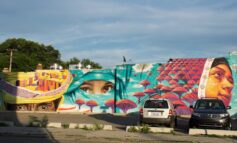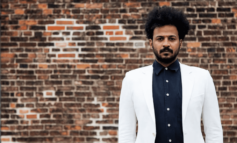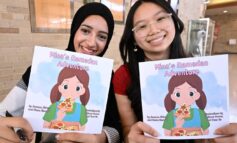It seems like an unlikely collaboration: an exhibit of 75 paintings by more than 10 Muslim artists from five different countries, co-sponsored by Southern University at New Orleans; the New Orleans African American Museum of Art, Culture and History; and the International Museum of Muslim Cultures, Jackson, Miss. But according to the curator of the show, the team makes a lot of historical sense.
“Muslims were and still are part of the history and culture of Africa and America,” said Egyptian-born Haitham Eid, 29, a graduate student in museum studies at Southern University who curated the International Muslim Artists Exhibition 2007. Eid, who earned his bachelor’s degree in archeology from Cairo University, called the African American art museum venue “a perfect fit” and said it shows “some cultural and art institutions in the United States [have] started to develop a path for Muslims to showcase their art and culture away [from] the complexity of political issues.”
The Muslim community in New Orleans is “getting bigger,” according to Eid, but funding the exhibit was a “major challenge” until Romanus Ejiaga, director of Southern University’s Center for African and African American Studies, helped secure the necessary funds.
Eid said all the artists in the show are Muslim, but he refused to discuss their observance levels. “As far as if these artists pray, fast and pay zakat, I really do not know,” he said. “Worship is a private relationship between the person, and God, and of course such relationships were not questionable in the application for the exhibition.”
What the exhibit does do, Eid said, is cater to “some art professionals in the West and the public,” who are not familiar with contemporary Muslim artists and their “interesting experience in developing modern techniques, styles and subjects.”
Asked why many Westerners believe Islam forbids art and is “aniconistic” (anti-images), Eid said he was not comfortable ruling on Islamic law, since “interpreting the verses of Qur’an and Hadith are very broad and you should receive a high degree certificate from a recognized university to be able to deal with such issues.” But, he added, the Qur’an “invites people to contemplate the universe and inside the human soul … There are no contradictions between the Qur’an and art or science.”
Okolo Rashid, co-founder and executive director of the Jackson-based International Museum of Muslim Cultures, met Eid when he applied for an internship at the museum in summer 2006. “It was Haitham’s strong work ethic and commitment that impressed me,” said Rashid, 58, who lives with her husband and four children in Capital City, Miss. “When he contacted us to do an internship from New Orleans, I just assumed he would be moving to Jackson.” But Rashid then learned that Eid intended to commute every week from New Orleans to Jackson to fulfill his internship work commitment. This convinced her that Eid was committed and serious in his outlook. “This was the biggest motivator for my support of his art exhibit project,” she recalled.
Rashid, who describes herself as an “African American Muslim,” founded IMMC in response to a major, multi-million dollar international exhibit called “Majesty of Spain” which came to Jackson. The show, though it was billed as an exploration of major Spanish cultural objects, completely ignored the nearly 1,000 years of Muslim rule of Spain from 711 until 1492. This was of course unacceptable to Rashid and her partner, Emad Al-Turk. When the two could not convince the exhibit planners to include Islamic contributions, they decided to curate their own show, which they called “Islamic Moorish Spain: Its Legacy to Europe and the West,” which accompanied the “Majesty” show and opened in April 2001. Rashid said at the time, the museum was the “first and only Muslim museum in the country.”
Like Eid, Rashid believes contemporary Islamic art is known only by “a select few Americans,” which is why it is so important that the exhibit provides “an opportunity for the African American community to be exposed to this important international exhibition, as it brings others segments of the New Orleans community to the New Orleans African American Museum of Art, Culture and History.”
Abdelrazek Eid, Haitham’s father, is one of the artists exhibiting in the show. He is 57 and lives in Egypt. His “Fear Terror” (a 9 x 12 inch watercolor painting), which originally hung in a show called “War and Man,” shows a distorted portrait of a man with purple, yellow and brown skin that appears to be peeling off. The figure’s bloated eyes stare off in different directions, and a blood red form, which could be either a hand or simply a shadow, grabs violently at the tongue. Where watercolor often is considered the domain of pretty flowers and shiny glazes, the artist uses the medium to do violence to his forms. He said he sought in the piece “to introduce to the audience new dimensions of using the watercolor in terms of technique and subject.”
Abdelrazek describes the context of the work as the frightening condition of contemporary life. “The world is surrounded by destroying bombs and dangerous weapons. The industry of inventing war and hate is widely spread everywhere,” he said via Haitham as translator. “This painting is a representation of my personal fear that man one day will destroy his achievements through the past centuries and leave nothing for the next generation but poorness and mess.”
“Art in general, just like a newborn, grows up from a stage to another,” he continued, reflecting upon the Islamic nature of his work. “Islamic art has passed by a certain period of time where the Muslim artist used the plants and animals as symbols and the geometric shapes and decoration as a way of creation.” But that Islamic art style was but “a representation of a certain period of time.” Contemporary Muslim artists now reflect different feelings and dreams through their art. “I am a Muslim artist with an Islamic experience and live in an Islamic community,” Abdelrazek said. “As a result, my art is a contemporary Islamic art.”





Leave a Reply